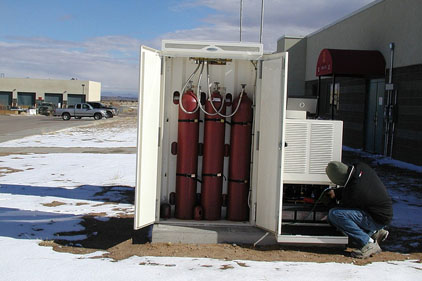
|
| The New Mexico Army National Guard implemented hydrogen fuel cells for backup power as part of a demonstration project. These fuel cells successfully powered several buildings for three days without drawing additional power from the state grid. (Photo courtesy of U.S. Army Environmental Command) |
Fuel Cells Emerging?
On Dec. 12, 2012, The NEWS noted that FuelCell Energy had announced the largest order ever received by the company and the fuel cell industry. The order was for 121.8 megawatts (MW) of fuel cell kits and services. The company said the estimated value of the multi-year contract was approximately $181 million.
On Dec. 17, 2012, our magazine reported that annual fuel cell system shipments were forecast to accelerate from 2012 to 2017. According to Pike Research (now Navigant Research), annual shipments for all applications would grow rapidly, from less than 29,000 in 2012 to more than 600,000 by 2017.
On Dec. 20, 2012, The NEWS reported that FuelCell Energy would be delivering a fuel cell power plant for data center project with Microsoft. The project is to evaluate the effectiveness of using fuel cells to efficiently use on-site biogas to power sustainable data centers.
On Jan. 25, 2013, our publication announced that WATT Fuel Cell Corp., a developer and manufacturer of solid oxide fuel cell (SOFC) systems, established a strategic licensing and supply agreement with Parker Hannifin Corp. The agreement, established through Parker’s Energy Systems business unit, allows for Parker’s production of a family of propane-driven, SOFC-based products for the RV, marine, over-the-road trucking, and residential markets.
On Jan. 29, 2013, The NEWS related that the stationary fuel cell market specifically was expected to reach more than 350,000 units shipped annually by 2022, growing from 21,000 in 2012, according to Pike Research (now Navigant Research).
On Feb. 15, 2013, our magazine reported that Cummins Inc. had made a strategic investment in ReliOn, a supplier of fuel cells for backup power and grid-support applications. Gary Flood, ReliOn’s CEO, said, “ Cummins is committed to assist ReliOn toward increasing our market visibility and access.”
And in a May 20, 2013 story, The NEWS noted that Navigant Research reiterated its outlook for a sharp increase in demand for stationary fuel cells, forecasting that annual revenue for these products would grow from $1.7 billion in 2013 to $9 billion in 2022.
This flurry of positive news about fuel cells in a short period of time certainly suggests that fuels cells are now making their mark. However, is this just a temporary blip on the radar?
Is Real Impact Still Years Away?
The article “Fuel Cells May Reshape Home HVAC” mentioned that “Fuel cells have been used in the U.S. space program since 1965.” Other technologies have come out of the space program and gone mainstream; fuel cells have not. Despite the fact that fuel cells have some history behind them, and despite the fact that the George W. Bush administration and the Barack Obama administration have pumped research and development dollars into them to help move the technology forward, fuel cells still remain little more than a niche product.
They continue to have promise. They continue to be touted as a product with a glowing future. But that future sometimes seems to be retreating rather than approaching.
And a recent report from Lux Research (The Great Compression: the Future of the Hydrogen Economy) asserts that the market for hydrogen fuel cells will remain “modest” even in 2030.
Lux Research stated that the dream of a hydrogen economy is no nearer, with hydrogen fuel cells becoming no more than “a modest $3 billion market of about 5.9 GW in 2030.”
High capital cost, and not hydrogen supply, is said to be the primary barrier to widespread application.
According to Lux, proton exchange membrane (PEM) fuel cells for the telecommunications industry, used for power and backup, will reach $1 billion in 2030, while fuel cells of all types for the residential, commercial, and utility generation markets will not prove to be cost effective. Lux sees the other $2 billion going to PEM fuel cells for forklifts and light-duty vehicles.
Of course, a technological advancement that cuts costs could change the outlook for fuel cells dramatically. But not everyone is convinced that the future for these products is rosy.
Publication date: 7/8/2013








